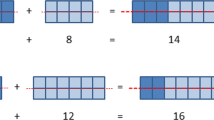Abstract
The purpose of this research is to construct a conceptual framework for use in capturing students’ unstable perception regarding the establishment of the universality of propositions through experimentation/measurement in school geometry. As a conceptual framework, this research uses a quadrangular–pyramid model comprised of five representative aspects: idealism/teleology, pessimism, optimism, actualism, and naïve pre-established harmony. In constructing the framework, I decided on the following viewpoints: (1) the students take as a criterion of the universality of propositions whether the proposition and the result of experimentation/measurement match or not; (2) the students assume that the result will always match the proposition; and (3) the students consider improving the method of experimentation/measurement based on whether the result matches or not. To illustrate the phenomenon of students’ unstable perception, I focus on the intermediate aspects between actualism and naïve pre-established harmony, in which the cognitive incoherence of students is conspicuous in that it is easy-to-manifest. I discovered two types of unstable perception through analyzing two 8th graders’ responses to questionnaires: (1) one student understood asymptotic accessibility to the match by improving the measurement, although the student was skeptical about reaching the final stage; and (2) another student understood the necessity of the match in order to guarantee her geometrical activity, although she was confused when confronted with the result in that it did not match, even when measured with high-precision equipment.
Similar content being viewed by others
References
Balacheff, N. (1988). Aspect of proof in pupil’ practice of school mathematics. In D. Pimm (Ed.), Mathematics, Teachers, and Children (pp. 216–238). Hodder and Stoughton, London.
Chazan, D. (1993). High School geometry student’s justification for their views of empirical evidence and mathematical proof. Educational Studies in Mathematics, 24(4), 359–387.
Fischbein, E. (1982). Intuition and proof. For the Learning of Mathematics, 3, 9–24.
Hadas, N., Hershkowitz & Schwarz, B.B. (2000). The role of contradiction and uncertainty in promoting the need to prove in dynamic geometry environments. Educational Studies in Mathematics, 44, 127–150.
Hanna, G. (2000). Proof, explanation and exploration: An Overview. Educational Studies in Mathematics, 44(1–2), 5–23.
Hanna, G. & Jahnke, H.N. (1996). Proof and proving. In A. J. Bishop (Eds.), International Handbook of Mathematics Education (pp. 877–908). Utrecht, Netherland: Kluwer Academic Publishers.
Hanna, G. & Jahnke, H.N. (1993). Proof and application. Educational Studies in Mathematics, 24(4), 421 – 438.
Harel, G. & Sowder, L. (1998). Students’ proof schemes: Results from exploratory studies. In A. Schoenfeld, J. Kaput, & E. Dubinsky (Eds.), Research in collegiate mathematics education III: Issues in Mathematics Education, Volume 7 (pp. 234–282). American Mathematical Society.
Hershkowitz, R., Dreyfus, T., Ben-Zvi, D., Friedlander, A., Hadas, N., Resnick, T., Tabach, M., & Schwarz, B. (2002). Mathematics curriculum development for computerized environments: a designer-researcher-teacher-learner activity. In L. English (Ed.), Handbook of International Research Mathematics Education (pp. 657–694). Mahwah, NJ: Lawrence Erlbaum Associates.
Koseki, K., Ieda, H., Kasuga, T., Kunimune, S., Kodera, T., Nakanishi, C., Yamashita, K. (1978). Teaching a demonstration in geometry: The first part. Journal of Japan Society of Mathematical Education (Mathematics Education), 60, 12–19. (in Japanese)
Koseki, K., Ieda, H., Kasuga, T., Kunimune, S., Enokido, A., Nakanishi, C., Yamashita, K. (1980). Teaching a demonstration in geometry: the third part. Journal of Japan Society of Mathematical Education (Mathematics Education), 62, 59–65. (in Japanese)
Kunimune, S. (1987). A developmental study on the understanding of significance of demonstration. In K. Koseki (Ed.), Teaching a demonstration in geometry (pp. 129–158). Tokyo: Meijitosho. (in Japanese)
Martin, W.G. & Harel, G. (1989). Proof frames of pre-service elementary teachers. Journal for Research in Mathematics Education, 20(1), 41–51.
Miyazaki, M. (2002). Investigative activity of truth of basic propositions for deduction in a local quasi-system: Its aspects in geometry of junior high school mathematic. Tsukuba Journal of Educational Study in Mathematics, 21, 21–30. (in Japanese)
Polya, G. (1954). Mathematics and plausible reasoning; vol.1, Princeton, NJ: Princeton University Press.
Porteous, K. (1991). What do children really believe?, Educational Studies in Mathematics, 21(2), 589–598.
Williams, E. (1979). An investigation of senior high school students’ understanding of the nature of mathematical proof’, Unpublished doctoral dissertation. University of Alberta, Edmonton. Canada.
Author information
Authors and Affiliations
Corresponding author
Rights and permissions
About this article
Cite this article
Miyazaki, M. Cognitive Incoherence of Students Regarding the Establishment of Universality of Propositions through Experimentation/Measurement. Int J of Sci and Math Educ 6, 533–558 (2008). https://doi.org/10.1007/s10763-007-9097-4
Received:
Accepted:
Published:
Issue Date:
DOI: https://doi.org/10.1007/s10763-007-9097-4




